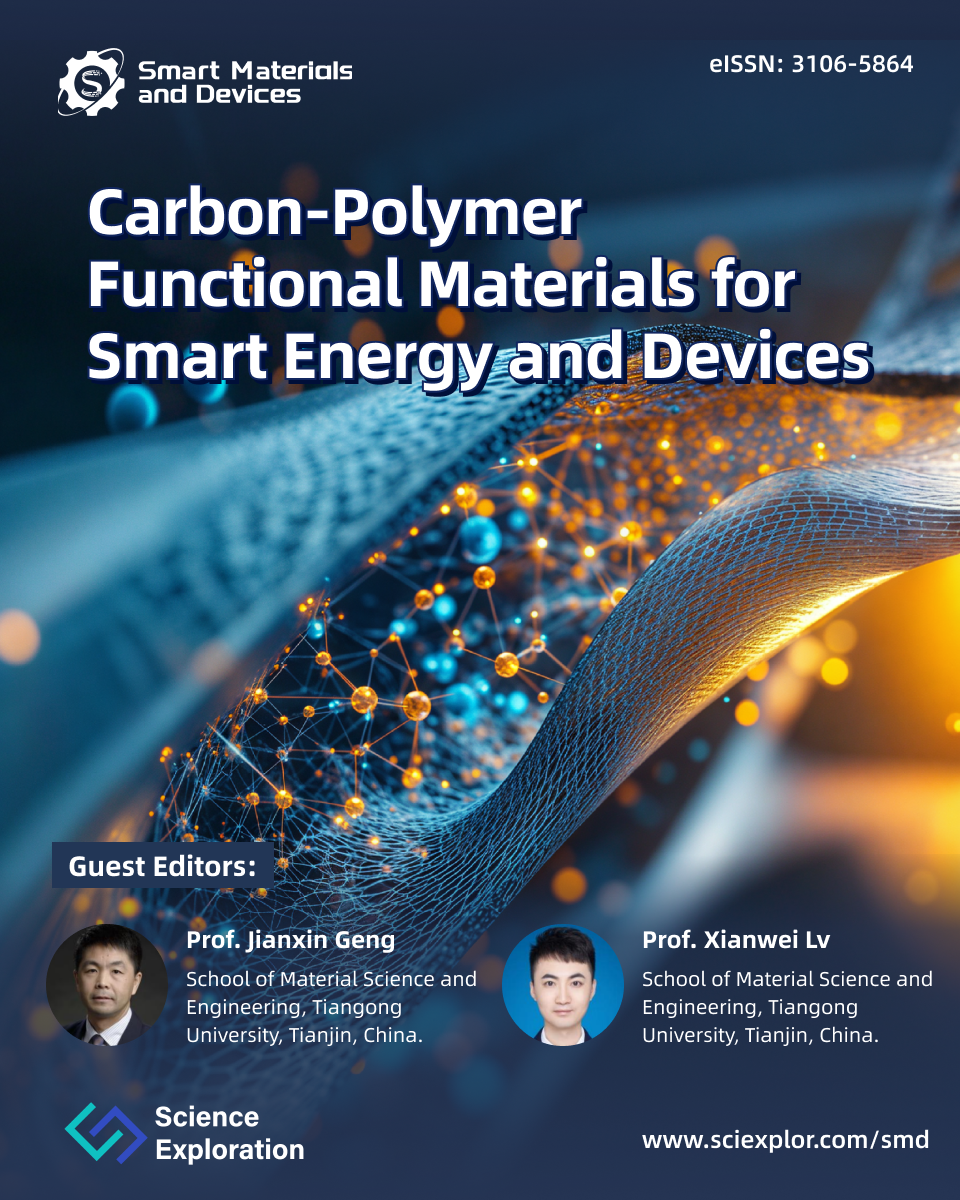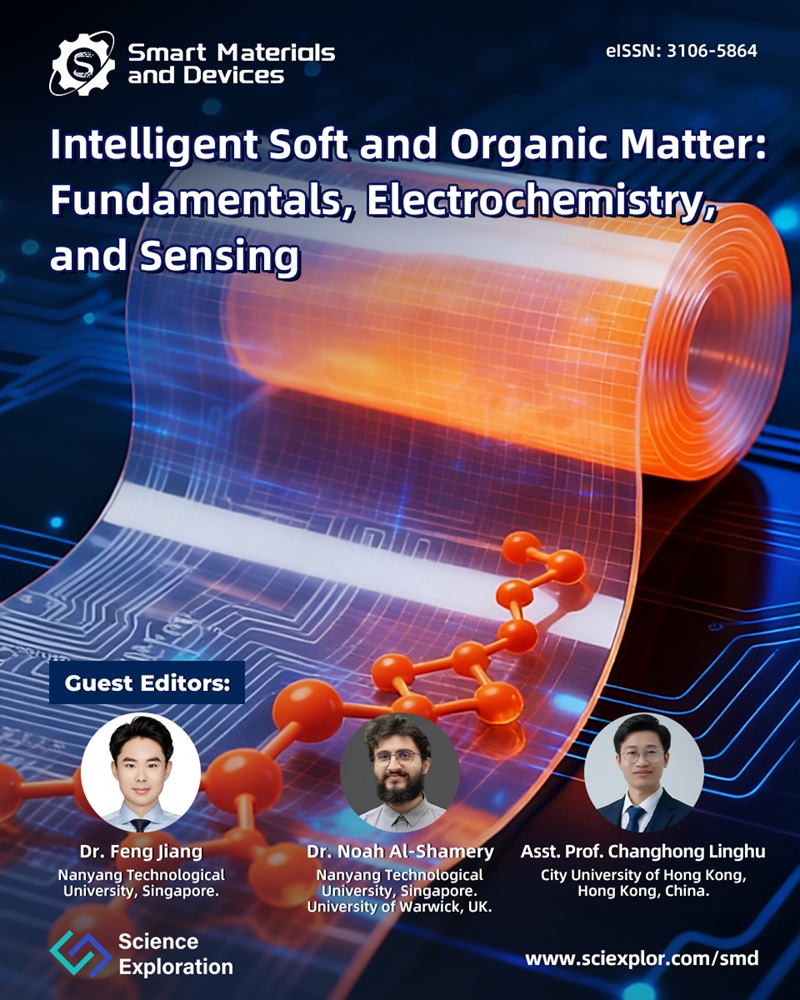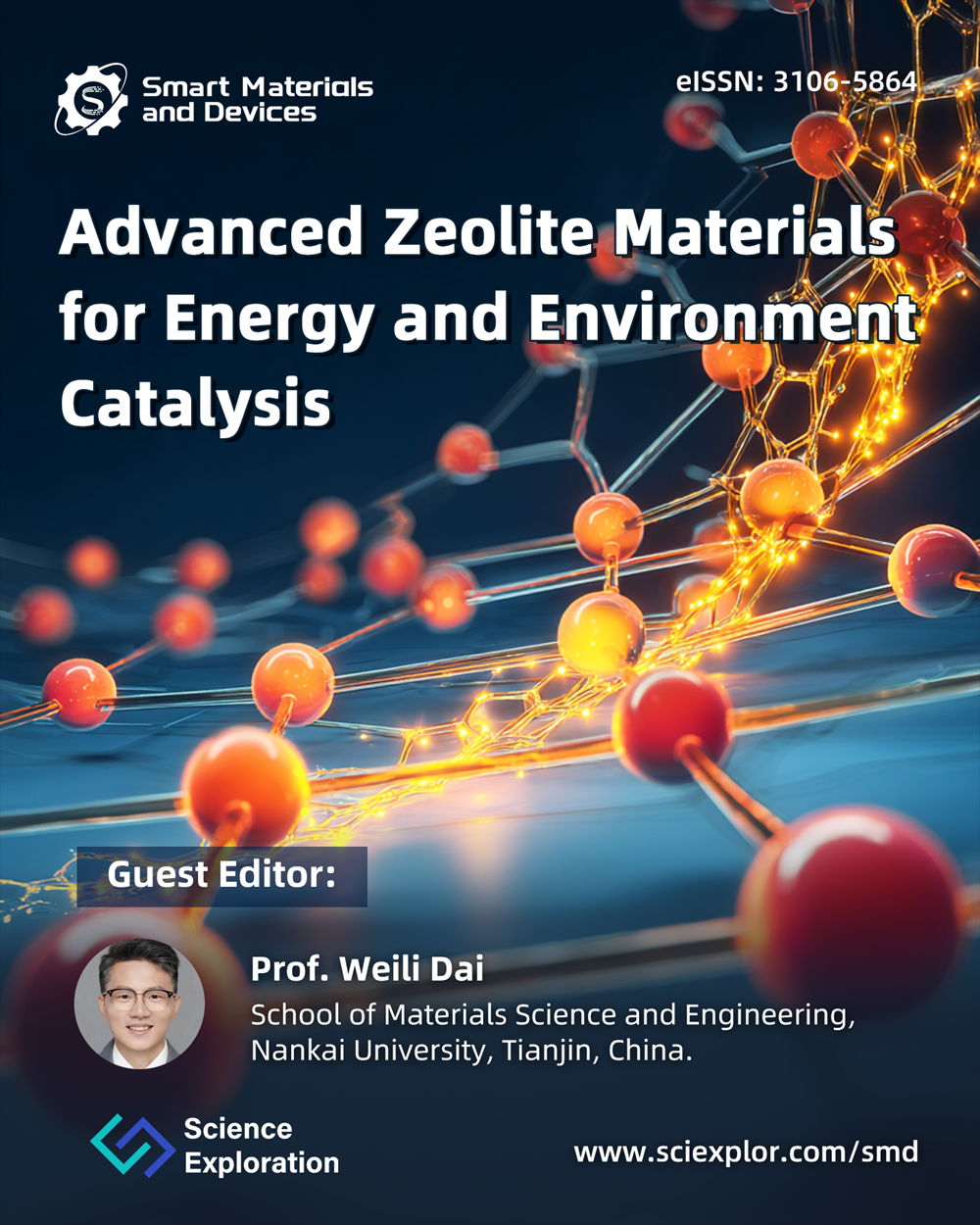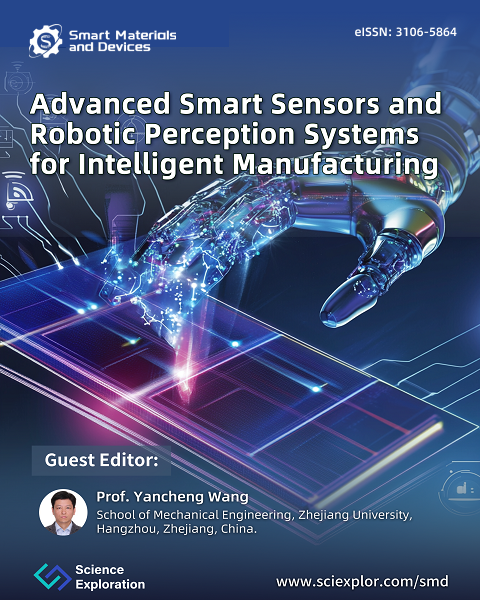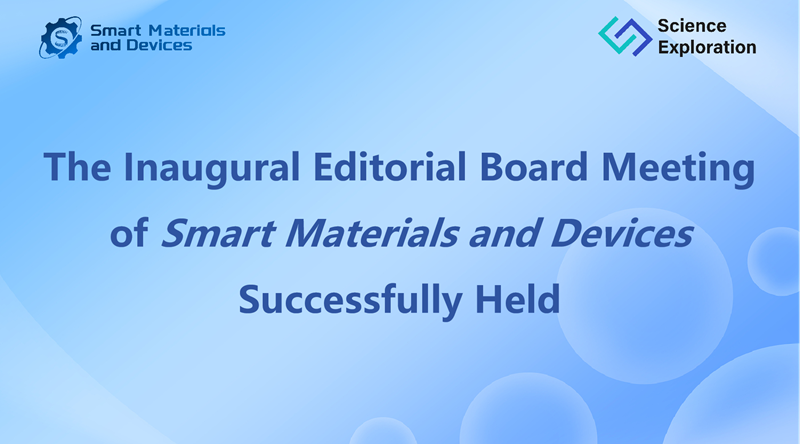
-
Smart Materials and Devices (SMD, Online ISSN 3106-5864) is a peer-reviewed, open-access journal dedicated to advancing the frontier of intelligent materials and their integration with cutting-edge technologies. SMD provides a premier platform for research that spans the development and application of smart materials, with a strong emphasis on the transformative role of artificial intelligence (AI). more >
Articles
Ru-TiO2 nanosphere arrays: Efficient nitrate reduction catalyst under strongly acidic and high-salinity conditions
-
Yicheng Li, ... Zhurui Shen
-
DOI: https://doi.org/10.70401/smd.2025.0022 - December 26, 2025
-
This article belongs to the Special Issue Smart Porous Materials and Catalysis
Liquid manipulating interfaces from natural prototypes to emerged devices
-
The aggregation, distribution, spreading, elongation and shrinking, as well as other behaviors of liquids, along with mass transfer and thermal exchange, are ubiquitous in both natural creatures and human daily life. These phenomena greatly inspire the ...
MoreThe aggregation, distribution, spreading, elongation and shrinking, as well as other behaviors of liquids, along with mass transfer and thermal exchange, are ubiquitous in both natural creatures and human daily life. These phenomena greatly inspire the advancement of liquid manipulating interfaces in theoretical models, production processes, and performance optimization. After decades of development, regulating liquid movements through surface chemistry, micro/nano structures, and geometrical gradients is becoming increasingly prevalent but still faces challenges. This review discusses the design principles of liquid manipulating interfaces, bionic prototypes and its models behind, and introduces their specific role within these works. We summarize state-of-the-art works from different motion dimensions, as well as the most widely mentioned applications. We believe this can inspire the transfer of bioinspired structures into functional devices through continued innovative breakthroughs and multidisciplinary collaboration.
Less -
Jiasong Liu, ... Moyuan Cao
-
DOI: https://doi.org/10.70401/smd.2025.0021 - December 18, 2025
-
This article belongs to the Special Issue Smart Porous Materials and Catalysis
Immobilized photocatalyst devices for scalable overall water splitting
-
Immobilized photocatalyst devices for overall water splitting (OWS) have emerged as a promising strategy for practical hydrogen production. Compared with traditional powder suspension systems, they offer great advantages, including scalability, facile ...
MoreImmobilized photocatalyst devices for overall water splitting (OWS) have emerged as a promising strategy for practical hydrogen production. Compared with traditional powder suspension systems, they offer great advantages, including scalability, facile recovery/replacement of photocatalysts, and the elimination of extra dispersion operations. Over the past decade, significant progress has been achieved in this field, especially in material screening, device construction, and system integration for scalable applications. However, up until now, there have been no related reviews focusing on this topic. This review aims to fill this gap by providing a comprehensive and structured overview of the immobilized photocatalyst devices for efficient OWS. Firstly, the basics of OWS process, including one-step and two-step photoexcitation mechanisms, are elaborated. Subsequently, recent advances in immobilized photocatalyst devices for scalable OWS via these two different approaches are summarized, based on which various solid-state electron mediators are classified and exemplified. The essential structure-performance relationship is also analyzed and revealed. Finally, the future prospects and challenges in this field are proposed and discussed.
Less -
Yifan Shao, ... Shanshan Chen
-
DOI: https://doi.org/10.70401/smd.2025.0020 - December 17, 2025
-
This article belongs to the Special Issue Smart Porous Materials and Catalysis
Preface of Special Issue on Smart Porous Materials and Catalysis
-
Zhong-Yong Yuan
-
DOI: https://doi.org/10.70401/smd.2025.0019 - November 11, 2025
-
This article belongs to the Special Issue Smart Porous Materials and Catalysis
Investigation of wheel-rail wear reduction by using MRF rubber joints with bidirectional adjustable stiffness
-
Stiffness of the primary longitudinal rubber joints is critical for both the high-speed stability and curve trafficability of the train. However, existing joints with fixed stiffness inevitably generate large wheel-rail lateral forces and wear on curves. ...
MoreStiffness of the primary longitudinal rubber joints is critical for both the high-speed stability and curve trafficability of the train. However, existing joints with fixed stiffness inevitably generate large wheel-rail lateral forces and wear on curves. To address this issue, a fail-safe rubber joint incorporating magnetorheological fluid (MRF) technology is proposed, enabling bidirectional variable stiffness. First, the structure and working principle of MRF rubber joint are described in detail. Subsequently, prototypes of the MRF damper and the MRF rubber joint are assembled and tested, yielding satisfactory variable damping and stiffness performance. Moreover, dynamic simulations further demonstrate the joint’s effectiveness in improving both stability and curve trafficability. A control algorithm based on track curvature identification is also proposed. The co-simulation results validate the potential of the MRF rubber joint on reducing wheel-rail wear and enhancing safety of trains.
Less -
Ning Gong, ... Shuaishuai Sun
-
DOI: https://doi.org/10.70401/smd.2025.0018 - September 30, 2025
Materials innovation for circularly polarized photodetectors
-
Circularly polarized light (CPL) features electromagnetic vectors that rotate regularly in a plane perpendicular to the direction of propagation, transmitting optical chirality information that is imperceptible to human beings. CPL can be classified ...
MoreCircularly polarized light (CPL) features electromagnetic vectors that rotate regularly in a plane perpendicular to the direction of propagation, transmitting optical chirality information that is imperceptible to human beings. CPL can be classified into the left-handed and right-handed circularly polarization light (L-/R-CPL), depending on whether the rotation direction is clockwise or anticlockwise, respectively. The ability to manipulate and characterize CPL is crucial for advancing various optical technologies, making the effective and direct detection of CPL extremely important. Breeding in the hotbed provided by the explosively increased chiral materials with CPL luminescence and strong circular dichroism (CD), CPL detectors are currently experiencing savage growth. Mainstream strategies can be divided into the leverage of photoactive materials with inherent chirality and the integration of chiral metamaterials with nonchiral photoactive materials. In this review, we not only highlight significant material innovations and detector architectures for CPL detection but also address the broader implications of these advancements. We discuss the challenges and future directions in this field, particularly focusing on how these developments could impact existing commodities, such as polarimetric imaging and security communications, and contribute to sustainability in technology through improved detection efficiency. Our goal is to inspire further promising developments in CPL photodetectors and encourage a broader application spectrum.
Less -
Jiajia Zha, ... Chaoliang Tan
-
DOI: https://doi.org/10.70401/smd.2025.0006 - March 12, 2025
Highly efficient hybrid tandem white organic light-emitting diodes with two different color-emitting units
-
White-color organic light-emitting diodes (WOLEDs) have aroused wide interests for future lighting because of low energy consumption in principle, while still suffer from the degradation by Joule heating and polaron-induced quenching under high luminance ...
MoreWhite-color organic light-emitting diodes (WOLEDs) have aroused wide interests for future lighting because of low energy consumption in principle, while still suffer from the degradation by Joule heating and polaron-induced quenching under high luminance caused by high current in practical. To obtain high current efficiency, which means high luminance at low current density, tandem WOLEDs with multiple electroluminescence (EL) units connected in series with charge generation layers (CGLs) have been developed. Here we report the improved hybrid tandem WOLED with two EL units, EL1 and EL2, where EL1 and EL2 generate fluorescent blue and phosphorescent yellow emissions from a metal-free material BCzVBi and a Ir-complex (fbi)2Ir(acac), respectively, with CGL composed of a HATCN/NPB bilayer. The white-light emitting device shows the maximum current efficiency and power efficiency of 60.2 cd/A and 29.6 lm/W, respectively, without out-coupling structure. A low driving voltage of 6.5 V at 1,000 cd/m2 is realized, which is an important value because such a luminance is required for actually employed lighting device. The blue emission appears from 5.4 V, and the light color changes from yellowish to bluish white during 5.4 V to 13.4 V, which could be explained by the energy level structures of the device and proved by the J-V characteristics. Additionally, this tandem WOLED also shows photovoltaic effect. This work provides a design of room light source whose color temperature could be tuned through applied voltage when needed, and a display system for low-current operated amorphous Si-TFT due to its high current efficiency.
Less -
Xiao Li, ... Lian Duan
-
DOI: https://doi.org/10.70401/smd.2025.0003 - January 13, 2025
-
This article belongs to the Special Issue Towards High-Performance and Long-Lifetime OLEDs
Engineering of transition metal phosphide-based heterostructures for electrocatalytic water splitting
-
Transition metal phosphides (TMPs) have been recognized as promising electrocatalysts for water splitting due to their high electronic conductivity, tunable structure and composition, and multifunctional active sites. Combining TMPs with other materials ...
MoreTransition metal phosphides (TMPs) have been recognized as promising electrocatalysts for water splitting due to their high electronic conductivity, tunable structure and composition, and multifunctional active sites. Combining TMPs with other materials such as metals and compounds to form heterostructures can significantly enhance electrocatalytic performance. This review summarizes recent advances in TMP-based heterostructures for electrocatalytic water splitting. The design of electrocatalyst structures and compositions, along with their corresponding electrochemical activities, is discussed. Emphasis is placed on interfacial engineering and the synergistic effects between heterocomponents to elucidate the relationship between interfacial characteristics and catalytic performance. Finally, current challenges and future research directions for TMP-based heterostructure electrocatalysts in water splitting are proposed.
Less -
Hui Zhao, Zhong-Yong Yuan
-
DOI: https://doi.org/10.70401/smd.2025.0013 - July 18, 2025
-
This article belongs to the Special Issue Smart Porous Materials and Catalysis
Management of charge and exciton for high-performance and long-lifetime blue OLEDs
-
High-performance and long-lifetime blue organic light-emitting diodes (OLEDs) are crucial for meeting the demands of advanced display and lighting technologies. Despite high device efficiency has been achieved in blue OLEDs, development of high-performance ...
MoreHigh-performance and long-lifetime blue organic light-emitting diodes (OLEDs) are crucial for meeting the demands of advanced display and lighting technologies. Despite high device efficiency has been achieved in blue OLEDs, development of high-performance and long-lifetime blue OLEDs still lag far behind their red/green counterparts due to the presence of long-lived high-energy triplet excitons and polarons. Given the critical role of charge and exciton management in both the emission and degradation processes of OLEDs, this review systematically summarizes strategies for suppressing charge leakage and exciton quenching, as well as for enhancing exciton utilization in blue fluorescent, phosphorescent, and thermally activated delayed fluorescent (TADF) OLEDs. In this context, we further discuss the roles of conventional fluorescent hosts, triplet-triplet annihilation/hot exciton hosts, TADF assistant hosts, phosphorescent assistant hosts, and exciplex/electroplex hosts in regulating charge and exciton dynamics in blue OLEDs. Additionally, the modification of emitting layer materials is highlighted as a key strategy for managing charge and exciton processes in efficient and stable solution-processed blue OLEDs. Based on current insights into the efficiency and operational stability of blue OLEDs, this review proposes feasible charge and exciton management strategies to address the current challenges.
Less -
Zhizhi Li, ... Shi-Jian Su
-
DOI: https://doi.org/10.70401/smd.2025.0009 - April 11, 2025
-
This article belongs to the Special Issue Towards High-Performance and Long-Lifetime OLEDs
Efficient deep-blue fluorescent material serving as emitter and host for high-performance organic light-emitting diodes
-
Blue emitters are highly desired in organic light-emitting diodes (OLEDs), but their electroluminescence efficiencies and roll-offs are always less than satisfactory. In this work, a triazine-based deep-blue emitter (2PhCzTRZ-Cz) is designed and synthesized. ...
MoreBlue emitters are highly desired in organic light-emitting diodes (OLEDs), but their electroluminescence efficiencies and roll-offs are always less than satisfactory. In this work, a triazine-based deep-blue emitter (2PhCzTRZ-Cz) is designed and synthesized. It prefers high thermal stability with a decomposition temperature of up to 543 °C, and possesses strong deep-blue photoluminescence. The doped OLEDs using 2PhCzTRZ-Cz as an emitter attain deep-blue lights at 418-424 nm, with high maximum external quantum efficiencies (ηexts) of 4.46-5.68%, maximum luminances of 2,820-7,400 cd m-2, CIEy values < 0.1 and small efficiency roll-offs. In addition, multiple-resonance thermally activated delayed fluorescence OLED by using 2PhCzTRZ-Cz as host realizes a high maximum ηext of 21.5%, significantly higher than those of the device based on traditional mCBP host (12.9%). These outstanding performances demonstrate the great potential of 2PhCzTRZ-Cz as an emitter and host for OLEDs.
Less -
Ting Guo, ... Zujin Zhao
-
DOI: https://doi.org/10.70401/smd.2025.0002 - January 09, 2025
-
This article belongs to the Special Issue Towards High-Performance and Long-Lifetime OLEDs
Materials innovation for circularly polarized photodetectors
-
Circularly polarized light (CPL) features electromagnetic vectors that rotate regularly in a plane perpendicular to the direction of propagation, transmitting optical chirality information that is imperceptible to human beings. CPL can be classified ...
MoreCircularly polarized light (CPL) features electromagnetic vectors that rotate regularly in a plane perpendicular to the direction of propagation, transmitting optical chirality information that is imperceptible to human beings. CPL can be classified into the left-handed and right-handed circularly polarization light (L-/R-CPL), depending on whether the rotation direction is clockwise or anticlockwise, respectively. The ability to manipulate and characterize CPL is crucial for advancing various optical technologies, making the effective and direct detection of CPL extremely important. Breeding in the hotbed provided by the explosively increased chiral materials with CPL luminescence and strong circular dichroism (CD), CPL detectors are currently experiencing savage growth. Mainstream strategies can be divided into the leverage of photoactive materials with inherent chirality and the integration of chiral metamaterials with nonchiral photoactive materials. In this review, we not only highlight significant material innovations and detector architectures for CPL detection but also address the broader implications of these advancements. We discuss the challenges and future directions in this field, particularly focusing on how these developments could impact existing commodities, such as polarimetric imaging and security communications, and contribute to sustainability in technology through improved detection efficiency. Our goal is to inspire further promising developments in CPL photodetectors and encourage a broader application spectrum.
Less -
Jiajia Zha, ... Chaoliang Tan
-
DOI: https://doi.org/10.70401/smd.2025.0006 - March 12, 2025
Engineering of transition metal phosphide-based heterostructures for electrocatalytic water splitting
-
Transition metal phosphides (TMPs) have been recognized as promising electrocatalysts for water splitting due to their high electronic conductivity, tunable structure and composition, and multifunctional active sites. Combining TMPs with other materials ...
MoreTransition metal phosphides (TMPs) have been recognized as promising electrocatalysts for water splitting due to their high electronic conductivity, tunable structure and composition, and multifunctional active sites. Combining TMPs with other materials such as metals and compounds to form heterostructures can significantly enhance electrocatalytic performance. This review summarizes recent advances in TMP-based heterostructures for electrocatalytic water splitting. The design of electrocatalyst structures and compositions, along with their corresponding electrochemical activities, is discussed. Emphasis is placed on interfacial engineering and the synergistic effects between heterocomponents to elucidate the relationship between interfacial characteristics and catalytic performance. Finally, current challenges and future research directions for TMP-based heterostructure electrocatalysts in water splitting are proposed.
Less -
Hui Zhao, Zhong-Yong Yuan
-
DOI: https://doi.org/10.70401/smd.2025.0013 - July 18, 2025
-
This article belongs to the Special Issue Smart Porous Materials and Catalysis
Highly efficient hybrid tandem white organic light-emitting diodes with two different color-emitting units
-
White-color organic light-emitting diodes (WOLEDs) have aroused wide interests for future lighting because of low energy consumption in principle, while still suffer from the degradation by Joule heating and polaron-induced quenching under high luminance ...
MoreWhite-color organic light-emitting diodes (WOLEDs) have aroused wide interests for future lighting because of low energy consumption in principle, while still suffer from the degradation by Joule heating and polaron-induced quenching under high luminance caused by high current in practical. To obtain high current efficiency, which means high luminance at low current density, tandem WOLEDs with multiple electroluminescence (EL) units connected in series with charge generation layers (CGLs) have been developed. Here we report the improved hybrid tandem WOLED with two EL units, EL1 and EL2, where EL1 and EL2 generate fluorescent blue and phosphorescent yellow emissions from a metal-free material BCzVBi and a Ir-complex (fbi)2Ir(acac), respectively, with CGL composed of a HATCN/NPB bilayer. The white-light emitting device shows the maximum current efficiency and power efficiency of 60.2 cd/A and 29.6 lm/W, respectively, without out-coupling structure. A low driving voltage of 6.5 V at 1,000 cd/m2 is realized, which is an important value because such a luminance is required for actually employed lighting device. The blue emission appears from 5.4 V, and the light color changes from yellowish to bluish white during 5.4 V to 13.4 V, which could be explained by the energy level structures of the device and proved by the J-V characteristics. Additionally, this tandem WOLED also shows photovoltaic effect. This work provides a design of room light source whose color temperature could be tuned through applied voltage when needed, and a display system for low-current operated amorphous Si-TFT due to its high current efficiency.
Less -
Xiao Li, ... Lian Duan
-
DOI: https://doi.org/10.70401/smd.2025.0003 - January 13, 2025
-
This article belongs to the Special Issue Towards High-Performance and Long-Lifetime OLEDs
Advanced carbon electrodes for supercapacitors: design strategies, performance optimization, and practical applications
-
Supercapacitors, renowned for their high-power density, rapid charge/discharge capabilities, and exceptional cycling stability, have emerged as promising solutions for sustainable and efficient energy storage. Among various electrode materials, ...
MoreSupercapacitors, renowned for their high-power density, rapid charge/discharge capabilities, and exceptional cycling stability, have emerged as promising solutions for sustainable and efficient energy storage. Among various electrode materials, carbon materials stands out due to its abundance, excellent electrical conductivity, chemical stability and structural versatility. This review explores the design strategies, performance optimization, and the expanding applications of carbon-based electrodes for supercapacitors. We first analyze the key factors that impact the performance of carbon electrodes for supercapacitors, including pore structure, surface chemistry, electrical conductivity and nanoscale architecture. Subsequently, we provide an in-depth analysis of recent advancements in the rational design of carbon materials, focusing on strategies for optimizing pore architecture, functionalizing surfaces, enhancing conductivity and designing nanostructures. By addressing performance limitations, the review highlights strategies that have significantly improved the efficiency of carbon electrodes. Furthermore, we explore the practical applications of carbon-based supercapacitors in wearable electronics,
Lessself-powered devices, and implantable systems. Lastly, we discuss the challenges and opportunities associated by carbon-based electrodes from the perspective of electrode design and practical application. -
Lei Liu, ... Ruliang Zhang
-
DOI: https://doi.org/10.70401/smd.2025.0008 - March 18, 2025
-
This article belongs to the Special Issue Smart Porous Materials and Catalysis
Management of charge and exciton for high-performance and long-lifetime blue OLEDs
-
High-performance and long-lifetime blue organic light-emitting diodes (OLEDs) are crucial for meeting the demands of advanced display and lighting technologies. Despite high device efficiency has been achieved in blue OLEDs, development of high-performance ...
MoreHigh-performance and long-lifetime blue organic light-emitting diodes (OLEDs) are crucial for meeting the demands of advanced display and lighting technologies. Despite high device efficiency has been achieved in blue OLEDs, development of high-performance and long-lifetime blue OLEDs still lag far behind their red/green counterparts due to the presence of long-lived high-energy triplet excitons and polarons. Given the critical role of charge and exciton management in both the emission and degradation processes of OLEDs, this review systematically summarizes strategies for suppressing charge leakage and exciton quenching, as well as for enhancing exciton utilization in blue fluorescent, phosphorescent, and thermally activated delayed fluorescent (TADF) OLEDs. In this context, we further discuss the roles of conventional fluorescent hosts, triplet-triplet annihilation/hot exciton hosts, TADF assistant hosts, phosphorescent assistant hosts, and exciplex/electroplex hosts in regulating charge and exciton dynamics in blue OLEDs. Additionally, the modification of emitting layer materials is highlighted as a key strategy for managing charge and exciton processes in efficient and stable solution-processed blue OLEDs. Based on current insights into the efficiency and operational stability of blue OLEDs, this review proposes feasible charge and exciton management strategies to address the current challenges.
Less -
Zhizhi Li, ... Shi-Jian Su
-
DOI: https://doi.org/10.70401/smd.2025.0009 - April 11, 2025
-
This article belongs to the Special Issue Towards High-Performance and Long-Lifetime OLEDs
Frontier Forums
Special Issues
Carbon-Polymer Functional Materials for Smart Energy and Devices
-
Submission Deadline: 31 Jul 2026
-
Published articles: 0
Intelligent Soft and Organic Matter: Fundamentals, Electrochemistry, and Sensing
-
Submission Deadline: 31 Jul 2026
-
Published articles: 0
-
Submission Deadline: 30 Jun 2026
-
Published articles: 0
Advanced Smart Sensors and Robotic Perception Systems for Intelligent Manufacturing
-
Submission Deadline: 31 Mar 2026
-
Published articles: 0






